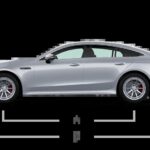Stepping into the Mercedes GLC, any concerns about its complex powertrain hindering performance quickly dissipate. Despite the intricate engineering beneath the surface, the powertrain operates with remarkable seamlessness in real-world driving. A variety of driving modes, including Comfort, Electric, and three performance settings—Sport, Sport+, and Race—allow drivers to fine-tune throttle response, stability control, suspension, and steering feel. Electric mode prioritizes all-electric driving, while Comfort, the default setting, intelligently balances gas and electric power based on driving conditions. The sport modes ensure the gas engine remains engaged, which also conveniently recharges the battery. Regardless of the selected mode, a firm press of the accelerator unleashes the GLC’s full power. While there’s a slight delay in Electric or Comfort mode as the gas engine engages, the available power is substantial once it kicks in.
Acceleration in the GLC is consistently smooth and even, devoid of any jarring transitions between electric and combined power sources. This is a notable advantage, as some plug-in hybrids can feel sluggish when relying solely on electric power. For instance, the Toyota Prius Prime demonstrates a significant drop in 0-60 mph time when switching from hybrid to electric mode. However, the GLC maintains respectable power (201 hp and 236 lb-ft) even in electric mode, making it suitable for city driving and highway passing.
Mercedes-Benz estimates a 0-60 mph time of just 3.4 seconds for the GLC 63 S, marginally quicker than the 3.5 seconds recorded for the previous V8-powered GLC 63 S. This slight improvement, despite a considerable increase in horsepower from the older model’s 503 hp, is likely due to the 2025 model’s anticipated weight gain from the added battery and hybrid components. Official specifications are pending, but the inclusion of a 6.1-kWh battery suggests a heavier vehicle compared to its predecessor.
Despite the potential weight increase, the GLC 63 S never feels cumbersome or sluggish. It delivers ample power for everyday driving scenarios, requiring open roads to fully exploit its capabilities. The transmission operates smoothly in most situations, yet delivers rapid upshifts in sport modes. The responsive paddle shifters enhance driver engagement, though the intelligent automatic transmission tuning generally selects the optimal gear.
Handling is another strong suit, with AMG engineers effectively mitigating the GLC 63’s weight. Standard adaptive dampers adjust suspension responsiveness based on road conditions and drive mode. Unlike some competitors, such as the BMW X3 M Competition which can be overly stiff, the GLC maintains a comfortable ride, even on imperfect surfaces. While ride firmness increases noticeably in Sport+ or Race modes, it remains manageable. The optional active roll stabilization, employing multi-piece anti-sway bars, further enhances comfort and performance by decoupling the anti-sway function as needed.
Cornering body roll is well-controlled, though the GLC exhibits slightly more lean than a sport sedan like the C 63 S. Similarly, brake dive is minimal but more pronounced than in a sedan. The brakes offer substantial stopping power, but the pedal feels firm and requires more effort than expected, especially during gentle stops. While drivers acclimate quickly to the pedal feel, a more immediate bite would be preferable. The available one-pedal driving function, offering four settings including off, lacks aggressive deceleration and doesn’t bring the vehicle to a complete stop. Disabling one-pedal driving is generally recommended. While not initially available, carbon-ceramic brakes are expected to become optional later.
Standard rear-axle steering enhances maneuverability and stability. At speeds below 62 mph (100 kph), the rear wheels turn slightly opposite to the front wheels, reducing the turning radius for easier parking and tighter cornering. Above this speed, the rear wheels turn in the same direction as the front wheels, improving high-speed stability. Unlike earlier rear-axle systems that could feel artificial, AMG’s implementation is seamless and natural. The GLC’s turn-in feels quicker than expected, enhancing responsiveness without feeling unnatural. The steering, while not offering extensive feedback, provides appropriate effort and a quick yet not overly sensitive ratio.
The GLC 63 S provides an enjoyable driving experience on winding roads, though truly tight corners may not fully unleash its potential. It requires more open space to fully demonstrate its capabilities, but it remains highly competent in most driving situations. While the new engine delivers impressive power and performance, the exhaust note lacks the auditory excitement of the previous V8 engine.
